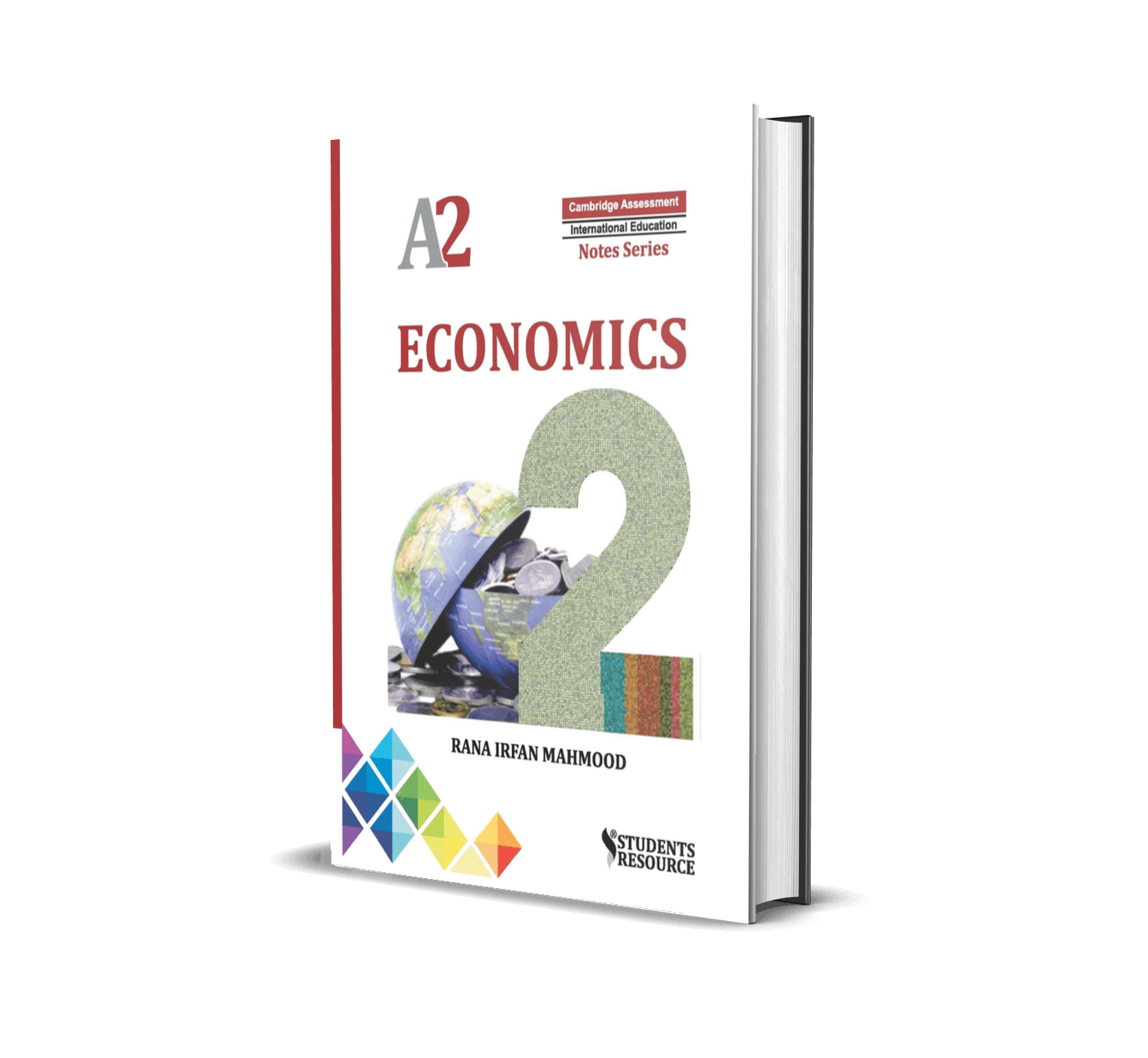AL Economics Revision Guide for A2 | Rana Irfan Mahmood
₨ 1,650
Series: A level Economics Notes for A2
Author, Writer: Rana Irfan Mahmood
Syllabus: Cambridge 2022-2024
Paperback: 168 pages
Publisher: Students Resource; 1st edition (February 25, 2021)
Language: English
Product Dimensions: 8.5 x 0.8 x 11 inches
Shipping Weight: 1kg
Available to ship in 1-2 days
Ships from and sold by
Students Resource Airport Road Lahore, Pakistan
| Book Author |
Rana Irfan Mahmood |
|---|
A Level Economics (A2) Notes by Rana Irfan Mehmood
Chapter 11: Consumer Behavior Analysis 5
11.1 Marginal Utility Approach
11.2 Marginal Utility and Individual Demand Curve
11.3 Law Of Equi-Marginal Utility
11.4 Ordinal Approach to Consumer Equilibrium
11.5 Budget Lines
11.6 Indifference Curve (IC)
11.7 Marginal Rate of Substation
11.8 Properties of Indifference Curves
11.9 Changes in consumer equilibrium
11.10 Derivation of demand curve IC approach: (X & Y Normal goods)
11.11 Role of advertisement and consumer equilibrium (I.C approach)
11.12 How far is the theory of consumer behavior valid?
Questions from Paper 3 MCQ’s
Questions from Paper 4 Theory
Chapter 12: Production, Cost and Revenue
12.1 Short run production analysis
12.2 Long Run Production
12.3 Production indifference curve / ISO Quant
12.4 Economics vs Accounting Costs
12.5 Short run Cost Concepts
12.6 Long run Cost Concepts
12.7 Minimum Efficient Scale of an Industry
12.8 Economies of Scale
12.9 Diseconomies of Scale
12.10 Small Scale Business and its benefits
12.11 Small Scale Business and its
12.12 Total Revenue, Marginal Revenue and Average Revenue Curves
12.13 Relationship Between AR, MR & TR Under Perfect Competition
12.14 Relationship Between AR, MR & TR Under Imperfect Competition
12.15 Elasticity of demand and revenue
Questions from Paper 3 MCQ’s
Questions from Paper 4 Theory
Chapter 13: Market Structure
13.1 Perfect Competition
13.2 Monopoly
13.3 Price Discrimination
13.4 Elasticity of demand and revenue
13.5 Oligopoly
13.6 Contestable Markets
13.7 Other Objectives of a Firm
13.8 The Concentration Ratio
13.9 Nudge Theory
Questions from Paper 3 MCQ’s
Questions from Paper 4 Theory
Chapter 14: Market Failure and Economic Efficiency
14.1 Market failure
14.2 Understanding externalities
14.3 14.3.1 (i) Negative production externalities
(ii) Negative consumption externalities
14.4 14.4.1 (i) Positive production externalities
(ii) Positive consumption externalities
14.5 Case of merit goods
14.6 Cost Benefit analysis
14.7 Economy Efficiency
14.8 The Two Parts of economic Efficiency
14.9 Dynamic Efficiency
14.10 X – Efficiency
14.11 Pareto Efficiency
Questions from Paper 3 MCQ’s
Questions from Paper 4 Theory
Chapter 15: Labour Market
15.1 Supply of an individual labour
15.2 Labor supply to a firm or industry
15.3 Determinants of labor supply in an economy
15.4 Perfect labor market
15.5 Demand for Labor
15.6 Demand for Labor and Marginal Productivity theory
15.7 Wages and profits under perfect competition
15.8 Critical evaluation of perfect labor market
15.9 Monopsony
15.10 Labor with market power
15.11 Firms and Labor with market power Bilateral monopoly
15.12 Government role in labor market
15.13 Other labour market imperfections
15.14 Transfer Earnings and Economic Rent
Questions from Paper 3 MCQ’s
Questions from Paper 4 Theory
Chapter 16: National Income
16.1 Gross Domestic Product (GDP)
16.2 Gross National Product (GNP)
16.3 Net National Product (NNP)
16.4 Measuring GDP with Output Approach
16.5 Moving from GDP to GNP
16.6 Moving from GNP to NNP
16.7 Market Price & Factor cost
16.8 National Income
16.9 Disposable Personal Income (D.P.I)
16.10 Per capita GDP
16.11 National Income is a Flow of Production not a Stock
16.12 Importance and Uses of National Income Measurement
16.13 Obstacles and Problems in Measurement of National Income
16.14 Circular Flow of National Income
16.15 In Open Economy
Questions from Paper 3 MCQ’s
Questions from Paper 4 Theory
Chapter 17: Classical & Keynesian Economics
17.1 Classical Economy
17.2 Keynesian Economics
17.3 Consumption and savings according to Keynes
17.4 Paradox of Thrift
17.5 Keynesian Theory of Income and Employment
17.6 Accelerator
17.7 Business cycle and interaction of multiplier and accelerator
17.8 Investment
17.9 Marginal Rate of Investment (MEI) and Cost of Funds
Questions from Paper 3 MCQ’s
Questions from Paper 4 Theory
Chapter 18: Macro Economic policies
18.1 Fiscal policy
18.2 Laffer Curve
18.3 (a) Central Bank
(b) Monitory policy
18.4 Supply side policies
Questions from Paper 3 MCQ’s
Questions from Paper 4 Theory
Chapter 19: Money Supply / Money Demand AND UNEMPLOYMENT
19.1 Money supply
19.2 Credit creation by commercial banks
19.3 Quantity Theory of Money
19.4 Liquidity Preference Theory
19.5 Loanable fund theory
19.6 Keynesian & Monetarism
19.8 Unemployment
19.9 Phillips Curve
Questions from Paper 3 MCQ’s
Questions from Paper 4 Theory
Chapter 20: Economic Growth and Economic Development
20.1 Economic growth and economic development
20.2 Economics Growth
20.3 Measurement of growth and economic development
20.4 Actual and potential output or GDP
20.5 Economic efficiency & equity
20.6 Developed and developing countries
20.7 Population growth
Questions from Paper 3 MCQ’s
Questions from Paper 4 Theory
Answer Keys of MCQ’s
Cambridge Exams Syllabus for 2018 onwards Exams


